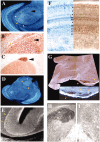FoxP2 expression in avian vocal learners and non-learners
- PMID: 15056696
- PMCID: PMC6730012
- DOI: 10.1523/JNEUROSCI.4369-03.2004
FoxP2 expression in avian vocal learners and non-learners
Abstract
Most vertebrates communicate acoustically, but few, among them humans, dolphins and whales, bats, and three orders of birds, learn this trait. FOXP2 is the first gene linked to human speech and has been the target of positive selection during recent primate evolution. To test whether the expression pattern of FOXP2 is consistent with a role in learned vocal communication, we cloned zebra finch FoxP2 and its close relative FoxP1 and compared mRNA and protein distribution in developing and adult brains of a variety of avian vocal learners and non-learners, and a crocodile. We found that the protein sequence of zebra finch FoxP2 is 98% identical with mouse and human FOXP2. In the avian and crocodilian forebrain, FoxP2 was expressed predominantly in the striatum, a basal ganglia brain region affected in patients with FOXP2 mutations. Strikingly, in zebra finches, the striatal nucleus Area X, necessary for vocal learning, expressed more FoxP2 than the surrounding tissue at post-hatch days 35 and 50, when vocal learning occurs. In adult canaries, FoxP2 expression in Area X differed seasonally; more FoxP2 expression was associated with times when song becomes unstable. In adult chickadees, strawberry finches, song sparrows, and Bengalese finches, Area X expressed FoxP2 to different degrees. Non-telencephalic regions in both vocal learning and non-learning birds, and in crocodiles, were less variable in expression and comparable with regions that express FOXP2 in human and rodent brains. We conclude that differential expression of FoxP2 in avian vocal learners might be associated with vocal plasticity.
Figures








References
-
- Banham AH, Beasley N, Campo E, Fernandez PL, Fidler C, Gatter K, Jones M, Mason DY, Prime JE, Trougouboff P, Wood K, Cordell JL (2001) The FOXP1 winged helix transciption factor is a novel candidate tumor suppressor gene on chromosome 3p. Cancer Res 61: 8820–8829. - PubMed
-
- Barami K, Iversen K, Furneaux H, Goldman SA (1995) Hu protein as an early marker of neuronal phenotypic differentiation by subependymal zone cells of the adult songbird forebrain. J Neurobiol 28: 82–101. - PubMed
-
- Basham ME, Sohrabji F, Singh TD, Nordeen EJ, Nordeen KW (1999) Developmental regulation of NMDA receptor 2B subunit mRNA and ifenprodil binding in the zebra finch anterior forebrain. J Neurobiol 39: 155–167. - PubMed
-
- Bentley GE, Spar BD, MacDougall-Shackleton SA, Hahn TP, Ball GF (2000) Photoperiodic regulation of the reproductive axis in male zebra finches, Taeniopygia guttata. Gen Comp Endocrinol 117: 449–455. - PubMed
Publication types
MeSH terms
Substances
Associated data
- Actions
- Actions
- Actions
- Actions
- Actions
LinkOut - more resources
Full Text Sources
